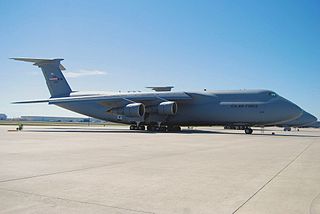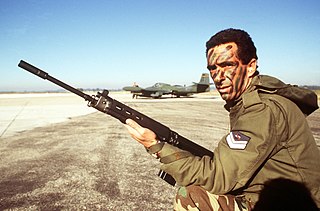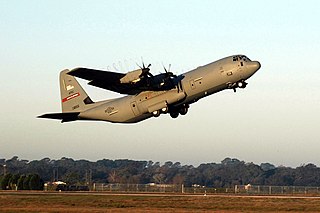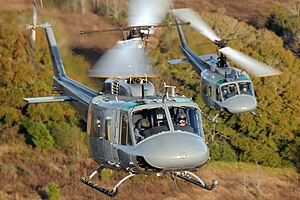
Quartier La Horie is a French Army base. It is located in the Moselle département, about 2 miles(3 km) west of the town of Phalsbourg, on the north side of the Route nationale 4 (N4) Highway adjacent to the village Saint-Jean-Kourtzerode; 29 miles (47 km) northwest of Strasbourg.

The 374th Airlift Wing is a unit of the United States Air Force assigned to Fifth Air Force. It is stationed at Yokota Air Base, Japan. It is part of Pacific Air Forces. The 374th Airlift Wing is the only airlift wing in PACAF and provides airlift support to all Department of Defense agencies in the Pacific theater of operation. It also provides transport for people and equipment throughout the Kantō Plain and the Tokyo metropolitan area.

Sewart Air Force Base (1941–1971) is a former United States Air Force base located in Smyrna, about 25 miles southeast of Nashville, Tennessee. During World War II, it was known as Smyrna Army Airfield.

The 89th Airlift Wing of the United States Air Force is based at Joint Base Andrews and has an operational force of over 1,000 personnel. The 89th provides global Special Air Mission (SAM) airlift, logistics, aerial transport and communications for the president, vice president, combatant commanders, senior leaders and the global mobility system as tasked by the White House, Chief of Staff of the Air Force, and Air Mobility Command.

The 57th Wing is an operational unit of the United States Air Force (USAF) Warfare Center, stationed at Nellis Air Force Base, Nevada.

The 839th Air Division is an inactive United States Air Force organization. Its last assignment was with Military Airlift Command, assigned to Twenty-First Air Force at Sewart Air Force Base, Tennessee, although except for the last month of its existence it was assigned to Tactical Air Command. It was inactivated on 31 December 1974.

The 483rd Tactical Airlift Wing was a tactical airlift and composite wing assigned to Pacific Air Forces during the Vietnam War. It was the host organization at Cam Ranh Bay Air Base South Vietnam from 1970–1972.

The 464th Tactical Airlift Wing was a theater airlift unit of the United States Air Force during the Cold War. It served in the United States under Tactical Air Command between 1953 and 1971. Its predecessor was the United States Army Air Forces 464th Bombardment Group of World War II.

The 356th Airlift Squadron is a United States Air Force Reserve squadron, assigned to the 433d Operations Group Air Force Reserve Command, stationed at Kelly Field Annex, Joint Base San Antonio, Texas. The 356th is a C-5M Super Galaxy Formal Training Unit.

The 309th Airlift Squadron is an inactive United States Air Force unit, last based at Chièvres Air Base, Belgium and assigned to the 86th Airlift Wing at Ramstein Air Base, Germany. It operated a single C-37 aircraft providing executive airlift for NATO.

The 549th Combat Training Squadron is a non-flying United States Air Force unit. It is assigned to the 57th Operations Group, and is stationed at Nellis Air Force Base, Nevada. It conducts air support and air interdiction sorties in "Green Flag (West)" exercises to train USAF fighter pilots and the aerospace power component to the US Army's brigade combat training.

The 32d Flying Training Squadron was last part of the 71st Flying Training Wing based at Vance Air Force Base, Oklahoma. It operated Beechcraft T-1 Jayhawk aircraft conducting flight training. It was inactivated on 14 September 2012.

The 20th Attack Squadron is a United States Air Force unit, based at Whiteman Air Force Base, Missouri. It currently flies the General Atomics MQ-9 Reaper and is assigned to the 432d Wing at Creech Air Force Base, Nevada.

The 315th Operations Group is a United States Air Force Reserve unit assigned to the 315th Airlift Wing. The unit is stationed at Charleston Air Force Base, South Carolina. The 315th Group controls all operational McDonnell Douglas C-17 Globemaster III flying squadrons of the 315th Airlift Wing. It was activated in 1992, when Air Force Reserve Command implemented the Objective Wing organization.

The 29th Weapons Squadron is a United States Air Force unit, stationed at Little Rock Air Force Base, Arkansas. It is assigned to the USAF Weapons School at Nellis Air Force Base. The mission of the squadron is to provide advanced Lockheed C-130J Hercules instructional flying.

The 24th Tactical Air Support Squadron was a ground attack squadron of the United States Air Force. It was last active at Nellis Air Force Base in Nevada, prior to being inactivated during December 2020.

The 516th Aeronautical Systems Group is an inactive group of the United States Air Force (USAF). It was last assigned to the 516th Aeronautical Systems Wing of Air Force Materiel Command at Wright-Patterson Air Force Base, Ohio.

The 345th Airlift Squadron is an inactive United States Air Force squadron most recently assigned to the 19th Operations Group at Keesler Air Force Base, Mississippi, where it was inactivated in June 2014. The squadron was activated in the summer of 2010 as an "active duty associate" squadron, jointly operating the Lockheed C-130J Hercules aircraft of the 815th Airlift Squadron.

The 346th Tactical Airlift Squadron is an inactive United States Air Force squadron that was last assigned to the 314th Tactical Airlift Wing at Ching Chuan Kang Air Base, Republic of China, where it was inactivated in May 1971.

The 347th Tactical Airlift Squadron is an inactive United States Air Force squadron that was last assigned to the 516th Tactical Airlift Wing at Dyess Air Force Base, Texas where it was inactivated in June 1972.





























